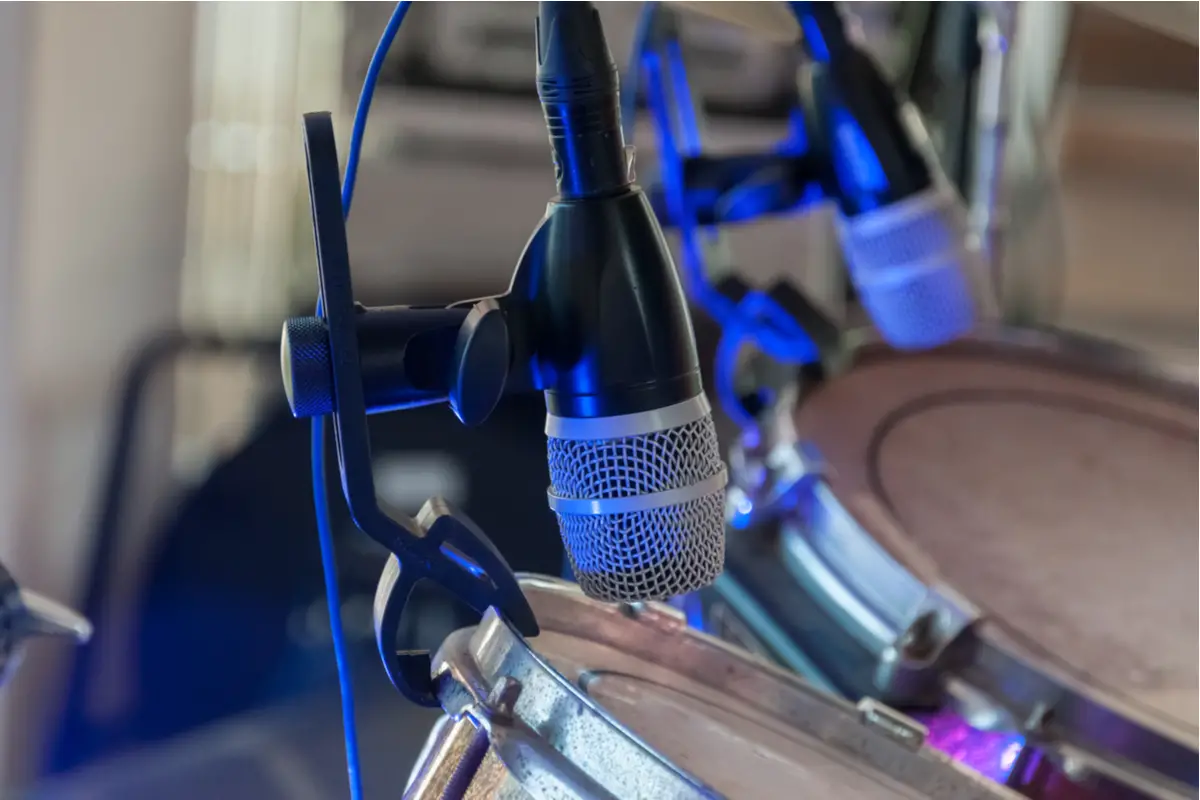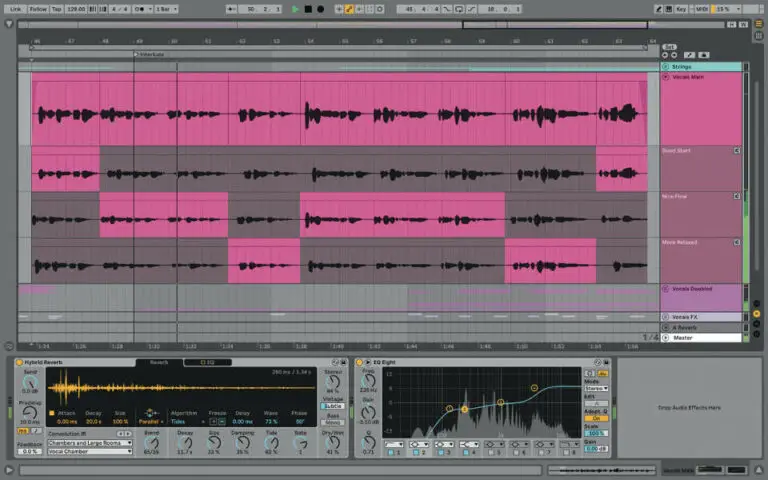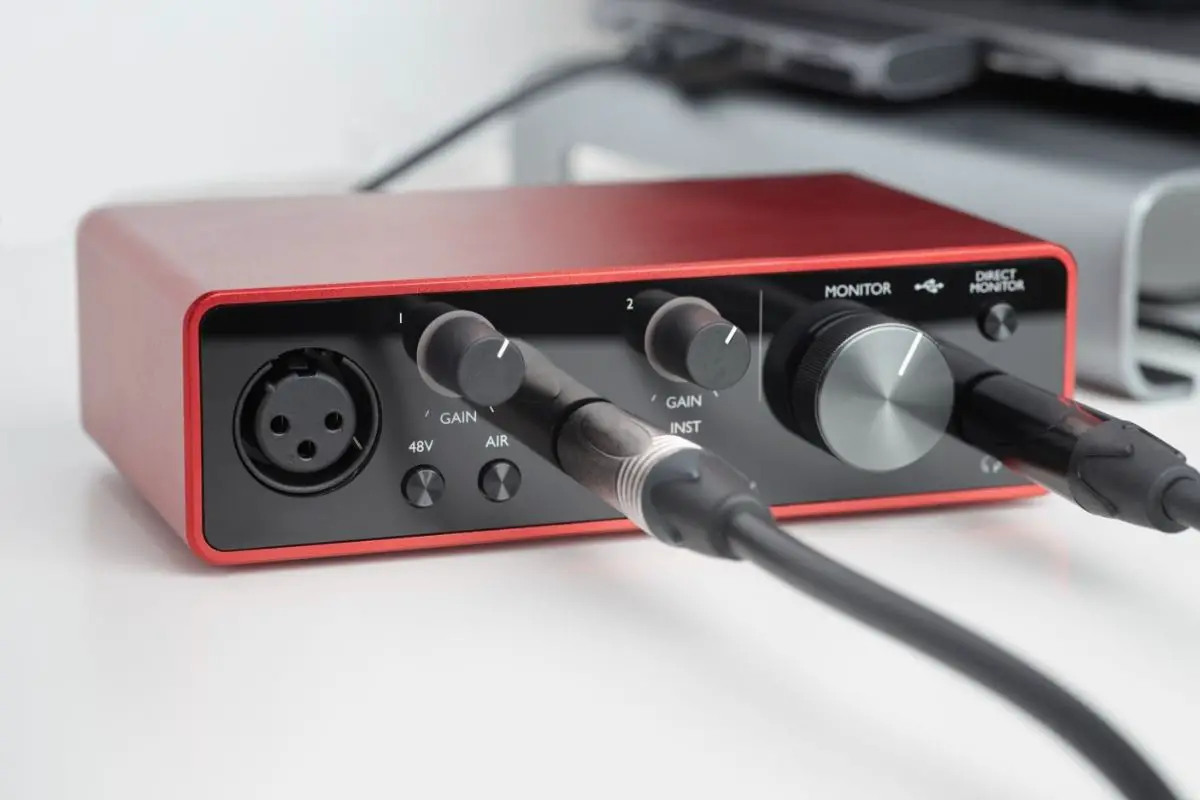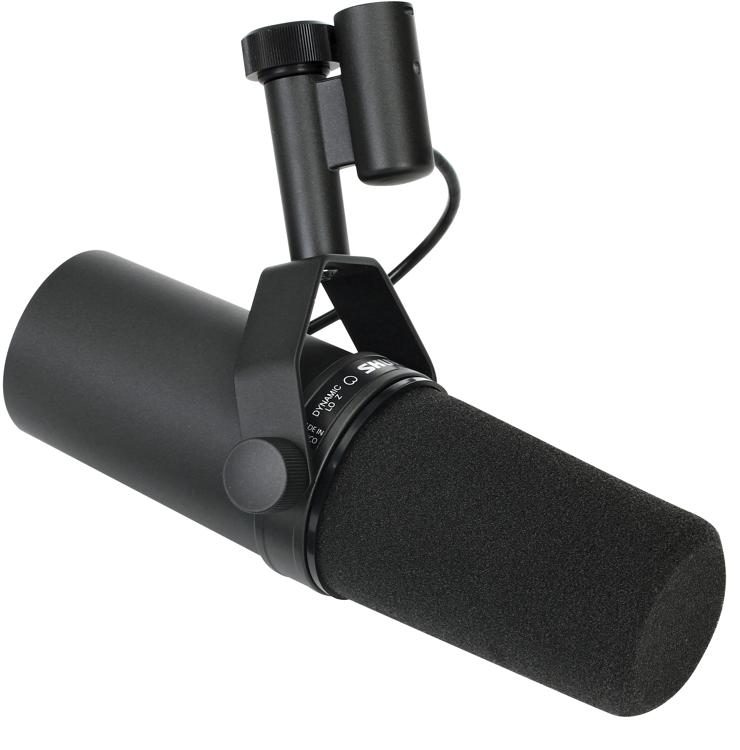Best Drum Mics for Live and Studio Recordings
There is nothing more aggravating than a crackly microphone, or a microphone of poor quality. You need a great microphone that syncs up your sound correctly.
Drum kits produce a lot of distinct noises. You get the bass drum, the crashing cymbals, and the snares. You need a microphone that will record these sounds accurately.
Well, look no further. In this article, we are going to give you some of the best drum mics, whether that’s a microphone kit or just a microphone.
11 Best Drum Mic Kits in 2023
1. Best Overall: Shure Beta 52A
Shure BETA 52A Kick Drum Microphone – Supercardioid Dynamic Mic with High Output Neodymium Element, Locking Stand Adapter, Durabl Steel Mesh Grille and Shock MountThe Shure Beta 52A has carved a niche for itself, especially among drummers and bass instrument players. This microphone’s appeal lies in its ability to capture low-frequency sounds, making it a favorite for kick drum and bass instrument recordings. The microphone’s design withstands the rugged environment of live performances, a feature that many users find appealing.
Customers appreciate the Shure Beta 52A for its sound quality that significantly enhances the drum beats, making a noticeable difference in the audio output. The microphone’s ability to deliver a punchy tone without requiring additional equalization is a highlighted feature. Users also commend the microphone for its reliable performance both in live and recorded settings, attributing this to its rugged design, which holds up well even in demanding circumstances.
However, not all reviews are glowing; some users find the sound control to be less precise, especially in the bass and medium frequency ranges. One review mentions that the microphone didn’t live up to their expectations due to a lack of precision in bass and medium frequencies.
Despite a few criticisms, the Shure Beta 52A remains a popular choice for many, owing to its robust build, reliable performance, and its special frequency response tailored for kick drums and similar low-bass instruments. The microphone’s reputation in the music industry, especially among drummers and bassists, is well-acknowledged, making it a staple in many professional and home recording setups across the globe.
What We Loved
- Excellent sound quality for kick drums and bass instruments.
- Rugged and reliable design suitable for live and studio settings.
- Appreciated for delivering a punchy tone without needing extra EQ.
- Standard in many recording studios due to its performance and affordability.
What You Need to Look Out For
- Some users found sound control, especially in bass and medium frequencies, to be less precise.
- A particular review mentioned saturation issues and a negative reaction to equalization.
- May not meet the expectations of users looking for a particular sound quality or frequency response.
2. Great for Kick Drums: AKG D112 Mk2
- Integrated flexible mount, makes it even more versatile
- Bass resounance volume chamber for unique, punchy sound
- Large diaphragm dynamic microphone, delivers accurate low frequencies
- Integrated hum-compensation coil, keeps noise to an absolute minimum
- Industry benchmark for bass drum microphone, used on stages worldwide for over 30 years
The AKG D112 Mk2 is a microphone that has garnered a reputation for capturing the robust and nuanced sounds of kick drums. This specialization comes across strongly as a go-to microphone for this purpose. Users appreciate the microphone for its professional quality, particularly in live sound environments like clubs or pubs, where its distinctive design makes it easily recognizable amidst a drum set.
The AKG D112 Mk2 is an upgrade from its predecessor, the MKI, showcasing a better performance and being a common sight in recording studios. Its presence in studios underscores its reliability and the quality of sound it produces, making it a staple for those looking to capture the deep resonances of kick drums.
Despite its strengths, every piece of equipment has room for improvement. While the user reviews lean towards the positive, there might be other microphones that professionals might prefer based on personal preferences or specific needs of a particular sound setup. However, the AKG D112 Mk2 holds its ground as a solid choice for those in need of a reliable kick drum microphone, reflecting its widespread use and positive reception in the music community.
What We Loved
- Exceptional performance with kick drums, capturing deep and punchy sounds.
- Professional quality making it a staple in live sound environments and recording studios.
- Recognizable and distinctive design.
What You Need to Look Out For
- There might be other microphones preferred by professionals for specific sound setups.
- An upgrade from its predecessor, but comparisons might lead to personal preferences for one over the other.
3. Excellent for Instrument Recording: Shure SM57
- EXEPTIONAL VOCAL PERFORMANCE – The SM57-LC delivers high-quality vocal reproduction, thanks to its tailored frequency response and brightened midrange for clear and present vocals.
- INDUSTRY STANDARD – The first choice for performers around the globe, the SM57 Dynamic Vocal Microphone is ready to bring any performance to life. From the club to the stadium, Shure has your back.
- CLARITY & CARE – The uniform cardioid polar pattern reproduces every note as it was intended, delivering warm, crisp sound time after time.
- LEAVE BACKGROUND NOISE BEHIND – The SM57 has a spherical mesh grille and built-in pop filter to keep any unwanted noise out of the mix.
- DROP THE MIC – The durable construction and break-resistant stand adapter makes the SM57 the perfect companion on the road, going strong through the toughest performances.
The Shure SM57 has stood the test of time, cementing itself as a reliable choice for musicians and sound engineers alike. Its enduring popularity is rooted in its versatility, ruggedness, and the quality of sound it delivers, particularly with instrument recording. This microphone shines when paired with a variety of instruments, showcasing a level of adaptability that has kept it relevant over decades.
One of the primary strengths of the SM57 is its ability to capture the sound of instruments. Its frequency response of 40Hz-15kHz makes it suitable for recording both instruments and vocals, offering a nuanced sound that enriches the outcome and provides more flexibility during the mixing stage. This wide frequency response is accompanied by a functional cardioid polar pattern which excels at off-axis rejection, ensuring that the sound captured is focused and clear.
The SM57 is built to endure. Its robust construction makes it capable of handling high sound pressure levels, up to 150 dB, which is beneficial when recording drums and loud guitar amps. The microphone’s design allows it to thrive under tough conditions, whether it’s unstable weather or rough handling, making it a reliable companion for both studio recording and live performances.
What We Loved
- Versatile, excelling in instrument recording.
- Wide frequency response and excellent off-axis rejection.
- Robust construction capable of withstanding high sound pressure levels and rough handling.
What You Need to Look Out For
- Lack of built-in features like filters or polar pattern adjustment.
- Not as well-suited for vocal usage compared to some other microphones due to the absence of a meshed grille at the tip, which can lead to sensitivity to lower frequencies when the sound source is close to the mic.
- Limited frequency range might not satisfy those looking for an excessive frequency range for specific uses.
- Amateur handling could result in handling noise or vibrations interfering with the main sound due to the lack of a built-in shock mount.
4. Excellent for Versatility: Beyerdynamic M 88 TG
- Dynamic microphone with highly defined hypercardioid polar characteristic and sensitive, accurate response
- Extended frequency range with very soft presence boost and exceptional bass reproduction
- High gain-before-feedback
- Integrated 20 dB hum-buck coil; high SPL handling capability
- Rugged construction; includes microphone clamp and storage bag
The Beyerdynamic M 88 TG has been celebrated for its versatility across a range of sound sources, making it a go-to choice for many audio professionals. Known for its hyper-cardioid dynamic features, this microphone can handle a variety of sound inputs without losing detail or becoming overly aggressive in tone. This characteristic makes it a preferred choice for both vocal and instrumental recordings, delivering a balanced sound that can adapt to different acoustic settings.
Users frequently comment on its performance with bass drums, where it notably excels, providing clear, powerful, and detailed sound that outperforms many other dynamic microphones in this application. However, its capabilities extend beyond kick drums, with reviewers also applauding its performance on vocals, flutes, violins, and other instruments, showcasing a warm sound signature that enhances both live performances and studio recordings.
Notwithstanding its strengths, a few users have pointed out some areas for improvement. For instance, its feedback rejection may not be as strong as some other microphones, and placement can be a bit critical to get the desired sound, especially on kick drums. Despite these minor issues, the Beyerdynamic M 88 TG remains a reputable and reliable microphone for a multitude of audio applications.
What We Loved
- Versatile with exceptional performance across a range of sound sources.
- Particularly excels with bass drum and vocal recordings, providing a warm and detailed sound.
- Durable construction suitable for both live and studio settings.
What You Need to Look Out For
- Feedback rejection might not be as strong as some other microphones.
- Placement can be critical for achieving the desired sound, especially on kick drums.
5. Excellent for Drum Recording: Earthworks DM20
- Earthworks DM20 DrumMic Close Miking Tom & Snare Cardioid Microphone – RM1 RimMount – PW1 Foam Windscreen – User’s Manual – Earthworks 15 Year Parts & Labor Warranty
- Compatibility: Snare and Tom Drums
- Frequency Response: 20Hz to 20kHz
- Polar Pattern: Cardioid
- Sensitivity: 8mV/Pa (-42dBV/Pa)
The Earthworks DM20 microphone is highly regarded among audio professionals, particularly for its excellence in drum recording. This small-diaphragm condenser microphone comes with a gooseneck, rim mount, and windscreen, making it a compact, yet robust choice for both live and studio applications.
Users often laud the DM20 for its clarity and precision when recording drums, appreciating the microphone’s ability to provide great isolation without sacrificing the tone and durability of the sound. One reviewer, a studio owner, particularly praised the DM20’s performance in jazz recording sessions, noting its discrete setup and great clarity for toms and snare top recordings. The reviewer also appreciated the easy setup facilitated by the stock mic clips included with the microphone.
Another seasoned engineer and producer emphasized the DM20’s performance in capturing snare sounds, which was described as a step up from other microphones they had used over decades of recording. The DM20 was particularly noted for its sound rejection capabilities, minimizing hi-hat bleed while maintaining a pleasing sound quality. The user appreciated the ease this microphone brought to their recording process, reducing the effort needed to achieve a good snare track sound, which was a refreshing experience for them.
What We Loved
- Exceptional clarity and precision in drum recording, particularly with toms and snare.
- Great sound isolation ensuring a clean, focused capture.
- Easy setup and discrete positioning facilitated by the included stock mic clips.
- Durable and robust design suitable for both live and studio settings.
What You Need to Look Out For
- Some users might find the price point a bit on the higher side given its specialized nature.
- Positioning and placement may require some trial and error to achieve the desired sound, especially in diverse acoustic environments.
6. Shure KSM32
- Cardioid polar pattern
- Utilizes an embossed, ultra-thin, high-compliance Mylar diaphragm
- Low frequency filter virtually eliminates background noise
- Shure-quality construction and pop protection
- 15dB switches pad for very high input SPL sources
The Shure KSM32 is a well-regarded large-diaphragm condenser microphone known for its versatility across a wide range of applications. It has found a niche both in studio recording and live sound arenas, showcasing a blend of affordability and performance that appeals to professionals and budding audio enthusiasts alike.
One user recounted a scenario where they were initially in the market for a more expensive Neumann TLM 103 but, based on a recommendation, decided to go for the Shure KSM32 instead. They were pleasantly surprised with the microphone’s performance, especially when recording vocals and acoustic guitars. The user noted the microphone’s ability to capture subtle nuances of sound with accuracy and clarity, making it a top choice for their recording needs.
What We Loved
- Versatile, catering to both studio recording and live sound applications.
- Affordable pricing without compromising on sound quality.
- Comes with a sturdy metal flight case and an elastic shock mount for added convenience.
What You Need to Look Out For
- Some users might prefer other models if looking for a more colored or specific sound signature.
7. Shure SM81
- This microphone requires phantom power and performs best with a 48 Vdc supply (IEC-61938). However, it will operate with slightly decreased headroom and sensitivity with supplies as low as 11 Vdc. Most modern mixers provide phantom power. You must use a balanced microphone cable: XLR-to-XLR or XLR-to-TRS.
- The SM81 is ruggedly constructed. It operates on phantom power and performs over a wide range of temperatures and humidity conditions. It is furnished with a swivel adapter, attenuator-switch lock, foam windscreen, and case for carrying and storage. Other accessories are available.
- 20 Hz to 20 kHz frequency response. Flat response curve for accurate reproduction of sound sources.
- Low noise and high output clipping level. Low distortion over a wide range of load impedances.
- Cardioid polar pattern, uniform with frequency and symmetric about axis, providing maximum rejection and minimum coloration of off-axis sounds
The Shure SM81 is highly esteemed within the audio community, particularly for its proficiency in capturing acoustic instruments like guitars, pianos, and cymbals. This microphone exhibits a flat frequency response, delivering a natural and realistic sound that is often praised by users. It manages a consistent high and low sound definition with minimal distortion, showcasing its ability to capture the subtleties and details of the sound accurately.
What We Loved
- Flat frequency response providing a natural and realistic sound.
- Excellent for recording acoustic instruments with high sound definition.
- Durable and reliable for both live and studio settings.
What You Need to Look Out For
- Some users noted a challenge with low-end distortions, although they are minimal and manageable with proper settings.
- May require additional amplification to match levels with other microphones due to its lower sensitivity.
8. Neumann KM 184
- Omni Directional
- Based on the famed KM series
- Versatile applications
- The Package Dimensions of the Product is 6.3″H x 9.84″L x 2.6″W
The Neumann KM 184 is revered among audio enthusiasts and professionals, especially for its prowess in capturing acoustic instruments like guitars and drums. This small diaphragm condenser microphone, a successor to the legendary KM 84, continues to uphold the Neumann legacy of delivering professional and pleasing sound quality. It’s a common sight in professional recording studios and is considered a must-have for audiophiles due to its detailed and clear sound reproduction across the frequency spectrum.
What We Loved
- Users particularly appreciate the KM 184 for its performance on acoustic guitars, drum overheads, and hi-hat applications, where it shines in capturing every nuance of the sound.
- The KM 184 exhibits a smooth frequency response which is often described as flat and natural, making it a suitable choice for various acoustic recording applications.
- With a low self-noise level of only 13 dBA, the KM 184 is capable of handling sound pressure levels up to 138 dB, ensuring a clean sound capture even in demanding acoustic environments.
What You Need to Look Out For
- Some users find the KM 184 a bit harsh in the upper mids, although pairing it with a warmer pre-amp can mitigate this concern.
- The KM 184, while offering exceptional sound quality, comes at a premium price, which might be a consideration for some users.
- The KM 184 requires +48V phantom power to operate, so ensure your audio interface or mixer can supply this.
9. Neumann U 87 Ai
- Switchable low frequency roll-off
- The studio microphone classic
- Pressure-gradient transducer with double membrane capsule
The Neumann U 87 Ai is a large-diaphragm condenser microphone revered for its outstanding versatility across a wide array of recording applications. This microphone, with a frequency response of 20 Hz – 20 kHz, offers three switchable polar patterns: cardioid, omnidirectional, and figure-8, accommodating various recording techniques. Known for its classic, warm sound pressure levels that flatter almost any sound source, it holds a special place in the world of audio recording, presenting character while preserving realism.
What We Loved
- The U 87 Ai excels in a multitude of scenarios, from studio vocals to recording kick drums and acoustic guitars, showcasing its adaptability.
- Known for delivering a round sound with a smooth, present low end, the U 87 Ai is often lauded for its warm sound pressure levels that offer a touch of character while maintaining realism.
- The U 87 Ai’s robust build quality reflects Neumann’s long-standing reputation for creating durable microphones that perform well for decades.
What You Need to Look Out For
- Some reviews mention a bit of harshness in the high-frequency ranges compared to the original U 87 or the U 87 A, which could be a consideration for potential buyers.
- The excellence of the U 87 Ai comes at a premium price, which may be a consideration for some individuals.
- Despite its studio excellence, the U 87 Ai is not recommended for live vocal recordings due to its high cost and other available options better suited for live applications.
10. Sennheiser E609 Microphone
- Supercardioid pickup pattern: Provides insulation from other on-stage signals
- Laterally-mounted capsule: Specially developed for miking guitar amps face-on and extermely close to the signal source
- Hum compensating coil: Reduces electrical interference
- Lightweight voice coil construction and rigid dome: Provide an extended high-frequency performance
- Metal construction: Rugged and reliable
The Sennheiser E609 microphone is often highlighted for its capability in close-miking guitar amplifiers both in studio and live settings. It’s a dynamic microphone with a supercardioid polar pattern which helps in achieving a focused sound capture, reducing the pickup of unwanted noise from the sides and rear of the microphone. It’s particularly noted for its flat-face design allowing easy positioning on guitar cabinets and its ability to withstand high Sound Pressure Levels (SPL) without distortion.
What We Loved
- Compact and versatile, making it a great addition to a setup, especially for capturing electric guitar sounds.
- Known for delivering genuine and natural tones from a guitar amp with true clarity resonance.
- The design inspired by the legendary Sennheiser MD 409, aiding in achieving a more natural-sounding pickup pattern.
- A high-performance response due to the use of neodymium ferrous magnets, and excellent tolerance to intense sound pressure levels, allowing for close miking without distortion.
- The flat-face design facilitates easy mic placement on amps, making it a practical choice for live performances as well as studio recordings.
What You Need to Look Out For
- Some users have found it to have too much fizz and hiss when miking a guitar cab, which could require additional mixing to fit well in a mix.
- The sound quality on snare drums was noted to be lacking by some users, indicating it might not be as versatile or reliable (sound-wise) for instruments other than guitars.
- While it performs well on electric guitars, it may not provide the same level of satisfaction on acoustic guitars or other instruments.
- Some users have mentioned that the microphone doesn’t perform as well in certain situations compared to alternatives like the Shure SM-57.
11. Solomon Mics Sub Microphone
- Size is everything. The Solomon lofreq is huge in the mix and only 7″ compared to a 10″ snare
- Recording studio and live stage use on kick drum, bass / guitar cabinets
- Attaches to standard microphone stand (5/8″ fine thread) – output jack: neutrik XLR
- Dynamic microphone – 6.5” Speaker driver – polar pattern: bi-directional – impedance: 150 ohms
- Customized in-line pad for controlled gain (gain and impedance designed to match beta 52)
The Solomon Mics Sub Microphone, known as LoFreq, is recognized for its unique ability to capture low-frequency sounds, particularly from kick drums, both in live and studio settings. This microphone offers a novel solution for achieving a ‘reverse speaker’ kick drum sound without the need for any modifications to your equipment.
What We Loved
- The LoFreq microphone is celebrated for its excellent low frequency reproduction, making it a favored choice for capturing the deep tones of kick drums.
- It’s a lightweight unit, weighing just 4.1lbs, making it easy to position and adjust around other microphones, especially in a crowded setup.
- Users appreciate its affordability and the innovative take on the ‘reverse speaker’ drum microphone concept, which previously might have been more cumbersome or expensive to achieve.
- The design of the microphone makes it visually appealing, and it has a solid build quality, ensuring durability over time.
What You Need to Look Out For
- Some users have mentioned that the microphone captures very little above 2-3 kHz, which might require pairing it with a more conventional microphone to get a full spectrum of sound.
- The microphone’s specialization in low-frequency sound capture might limit its versatility for other recording applications.
- There’s a learning curve to finding the most effective positioning and pairing with other microphones to achieve the desired sound, especially for those unfamiliar with this style of microphone.
Buyer’s Guide For Finding the Best Microphones for Recording Drums
Purchasing a drum mic is an important investment, and you need to consider several aspects. You also need to decide whether you want to invest in a singular drum microphone or a microphone kit. Below is a buyer’s guide to help you decide.
Dynamic VS Condenser Microphones
When buying a microphone kit, make sure that your kit has at least one of each type of microphone.
Dynamic mics and condenser mics have different purposes. Condenser microphones are more sensitive, and they can pick up a wide range of frequencies.
A condenser microphone like having a microphone on maximum gain. You pick up a lot of things that you would not get with a dynamic microphone.
A dynamic microphone can identify and record high sound pressure levels, meaning you can place them directly on a drum.
They are especially good for bass drums, as they will pick up the lower and deeper frequencies better than a condenser microphone.
How the type of drum you play impacts the mic you buy
You should consider what microphone you may buy based on what kind of drum or instrument you are going to use it for. This includes cymbals, too.
There are drum microphones designed for most kinds of drum kits. When you want to buy a microphone or a microphone kit, you need to know what the company designed the microphone for.
A dynamic microphone will struggle to pick up cymbal sounds, and they may not capture the quality in comparison to a condenser microphone.
If you are looking to record your bass drum mainly, you will want to look into dynamic microphones instead of condenser microphones. It is something a lot more important than you may think.
What is a good price for a drum mic?
Microphones can be rather expensive. Companies price most microphones at over $150. You will struggle to find a microphone of good quality if it costs you less than $100.
Microphones that are priced over $100 will produce excellent quality recordings, and this is definitely something that is good for getting the most from your drum kit, as well as your mic.
What accessories should come with a drum mic kit?
You don’t need accessories for a great microphone or microphone kit. However, it does help the recording. Having good accessories can bring out some exceptional sounds.
Having mounts and clips will make it a lot easier to attach your microphones to the drums. This keeps them secure and steady whilst playing the drums.
Stands, clamps, and mounts are ideal to attach the microphones to your drum rims, and you can get the best sound quality that you desire.
It is helpful to have a microphone case or carrier, especially if you have a microphone kit rather than a singular microphone. If you plan on gig working, needing to easily move your mic kit is important.
Frequently Asked Questions
Are Condenser Microphones Better?
Condenser microphones are slightly better for recording live drums. They do not receive any horrible feedback because they can record high frequencies. This means they can record cymbals very well.
Are Vocal Microphones Good For Drums?
Vocal microphones pick up a good range of frequencies. They can add extra depth to your recording, but they may struggle to record good quality cymbal sounds, as this is usually out of their frequency.
How do drum mic kits cater to different recording needs?
Drum mic kits often come with a variety of microphones designed for specific drum components. For example, some drum microphone kits come with close-recording and overhead mics. You might also get specialized mics to capture specific sounds.
What features should I look for in overhead drum mics?
Overhead drum mics with a cardioid pickup pattern are ideal for isolation. Features like an on/off switch can be helpful for muting on stage or when using multiple microphones, especially in live or studio settings where you may want to keep certain instruments isolated from others.
Which microphones are best for drum overheads and room recording?
Microphones with multiple polar patterns and cardioid polar patterns are recommended for recording cymbals, drum overheads, and room recording due to their ability to capture a broad spectrum of sounds accurately.
What should I consider when looking for a microphone for live drumming situations?
Consider microphones with good isolation features, easy muting options, and those that come in kits to ensure you have all the necessary mics for different drum components. The ability to withstand high Sound Pressure Levels (SPL) without distortion is also a crucial factor.

















